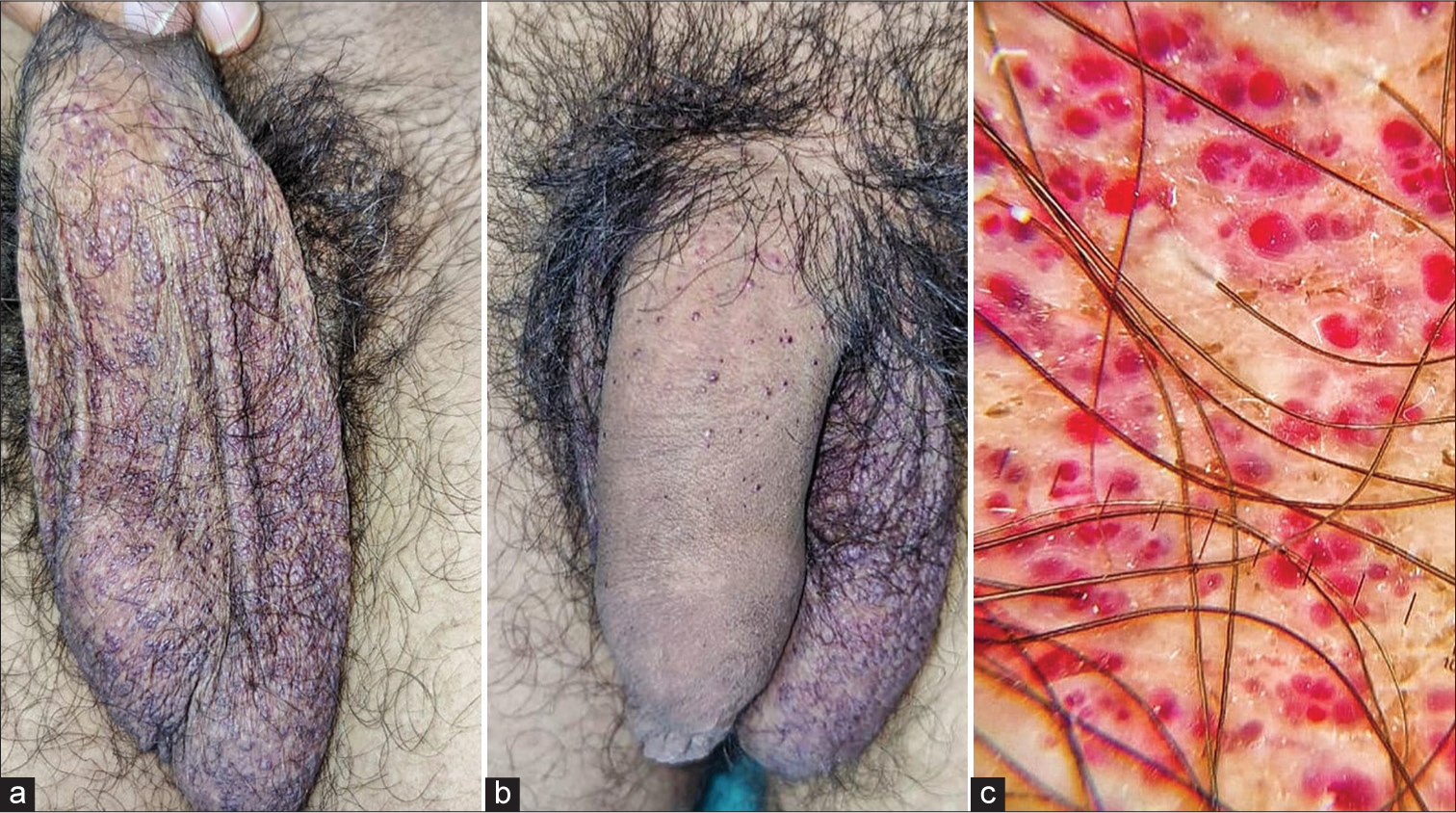Translate this page into:
Angiokeratoma Corporis Diffusum Universale
*Corresponding author: Anurag Verma, Department of Dermatology, Venereology and Leprosy, Mayo Institute of Medical Sciences, Barabanki, Uttar Pradesh, India. iamanuragderma@gmail.com
-
Received: ,
Accepted: ,
How to cite this article: Saini A, Goyal M, Tomar SS, Verma A. Angiokeratoma Corporis Diffusum Universale. Indian J Postgrad Dermatol. 2024;2:135-7. doi: 10.25259/IJPGD_119_2023
CASE DESCRIPTION
A 22-year-old male with multiple angiokeratomas distributed in a bathing trunk pattern with heat intolerance and bilateral sensorineural hearing loss on pure tone audiometry. Histological examination of lesions revealed ectatic capillaries with focal areas of hyperkeratosis.
HISTOPATHOLOGIC FINDINGS
A 22-year-old male of normal intelligence, born of non-consanguineous parents, presented with complaints of multiple asymptomatic dark-coloured lesions over body. On cutaneous examination, multiple discrete asymptomatic red to violet non blanchable, keratotic papules were seen over scrotum and shaft of penis suggestive of angiokeratoma. On further cutaneous examination, multiple red-to-brown coloured pinpoint macules were present extending from umbilicus to mid-thigh in a bathing trunk distribution [Figures 1, 2a and 2b] with some lesions over extensors of arm and palm. The flexural and mucosal surfaces were spared. Multiple telangiectasias were also noticed over his face and neck. A dermoscopic examination of the papules showed sharply demarcated group of dusky red and dark blue lacunae with whitish veils surrounding them [Figure 2c]. Clinical and dermoscopic examination was suggestive of ‘angiokeratoma corporis diffusum (ACD) universale.’ Patient noticed the lesions at around 10 years of age and there has been no increase in their number or size since then.

- (a) Multiple angiokeratomas present over the bathing trunk area, (b) Inset shows zoomed image of the angiokeratomas.

- (a) Multiple angiokeratomas present over the scrotum, (b) Multiple angiokeratomas seen over the shaft of penis, (c) Dermoscopy shows sharply demarcated group of dusky red and dark blue lacunae with whitish veils surrounding them (Heine NC2, ×10).
He also had history of excessive sweating and heat intolerance. He had no hearing complaints; however, pure tone audiometry revealed bilateral mild sensorineural hearing loss. Intelligence was normal. There are no complaints of frothy urine, nausea, vomiting, fever and headache. His mother suffered from acute myocardial infarction at the age of 40 years, but the patient was unaware if she had similar skin lesions as well.
The patient’s medical examination did not reveal any abnormality. However, his ophthalmological examination showed tortuous retinal vessels and pure tone audiometry of the patient revealed bilateral mild hearing loss. Routine blood investigations were all within normal limits. Abdominal ultrasound, chest X-ray, electrocardiography and treadmill test did not show any abnormality. A Doppler echocardiogram of soft tissues showed no underlying arterial or venous malformations. Due to lack of facilities, specific test to detect alpha-galactosidase-A could not be performed. Biopsy of a papule showed multiple dilated capillaries [Figure 3a] with normal appearing endothelial cells and plenty of red blood cells within the lumen in the papillary dermis [Figure 3b]. Overlying epidermis was thinned out and acanthotic epidermis was seen encircling superficial ectatic capillaries with focal areas of hyperkeratosis. Adnexal structures were well preserved and mild diffuse infiltrates predominantly consisting of lymphocytes were present in the superficial dermis in between collagen bundles. The patient was counselled for regular health check-ups.

- (a) Multiple superficial, dilated capillaries with vacuolated endothelial cells seen (×40 H&E stain), (b) Red blood cells seen in the lumen of papillary dermis with overlying thinned out and acanthotic epidermis (×40 H&E stain). H&E: Haematoxylin and eosin.
DIAGNOSIS
ACD Universale.
DISCUSSION
Angiokeratomas, as the name suggests, are capillary malformations with overlying epidermal hyperkeratosis. They can be classified as localised or generalised forms. Localised can be solitary or multiple, such as Fordyce’s angiokeratoma (on scrotum or the vulva), Mibelli’s angiokeratomas (on bony prominences of hands and feet) and angiokeratoma circumscriptum naeviforme (congenital, large plaques over lower limbs).[1,2] In the generalised form which is ACD, widespread angiokeratomas seem clustered symmetrically over the ‘bathing trunk’ area of the body. ACD was earlier synonymous with Fabry disease (FD) which is an X-linked recessive disorder with the deficiency of α-galactosidase A enzyme. However, now, it is known to also be associated with other lysosomal storage disorders such as GM1 gangliosidosis, aspartylglucosaminuria, fucosidosis, β-mannosidosis, sialidosis, galactosialidosis and Kanzaki disease. In Anderson FD, angiokeratomas usually appear before puberty and gradually increase in number.[1] On dermoscopy, these appear as well-defined red lakes.[3] Histopathology of these lesions reveals ectatic capillaries in the superficial dermis with overlying hyperkeratosis of the epidermis.[4]
All lysosomal disorders usually have similar findings; however, FD is the only one without any impairment of intelligence.[4] As our patient was of normal intelligence, presenting with ACD, we suspected Anderson FD. Our patient also presented with acroparesthesias, increased sweating, heat intolerance, tortuous retinal vessels on direct ophthalmoscopic examination and sensory neural hearing loss on pure tone audiometry. Since our patient also gives a history of his mother having myocardial infarction at an early age, with this incidental diagnosis, we show the importance of early detection and follow-up in such cases to prevent serious systemic complications.
Ethical approval
Institutional Review Board approval is not required.
Declaration of patient consent
The authors certify that they have obtained all appropriate patient consent.
Conflicts of interest
There are no conflicts of interest.
Use of artificial intelligence (AI)-assisted technology for manuscript preparation
The authors confirm that there was no use of artificial intelligence (AI)-assisted technology for assisting in the writing or editing of the manuscript and no images were manipulated using AI.
Financial support and sponsorship
Nil.
References
- Angiokeratoma Corporis Diffusum (Fabry Disease) Dermatol Online J. 2005;11:8.
- [CrossRef] [PubMed] [Google Scholar]
- Familial Angiokeratoma Corporis Diffusum without Identified Enzyme Defect. Indian J Dermatol Venereol Leprol. 2015;81:46-9.
- [CrossRef] [PubMed] [Google Scholar]
- Genital Angiokeratoma in a Woman with Fabry Disease: The Dermatologist's Role. An Bras Dermatol. 2018;93:426-8.
- [CrossRef] [PubMed] [Google Scholar]
- Angiokeratoma Corporis Diffusum: An Uncommon Case with Suspected Anderson Fabry Disease. Indian Dermatol Online J. 2020;11:212-5.
- [CrossRef] [Google Scholar]






